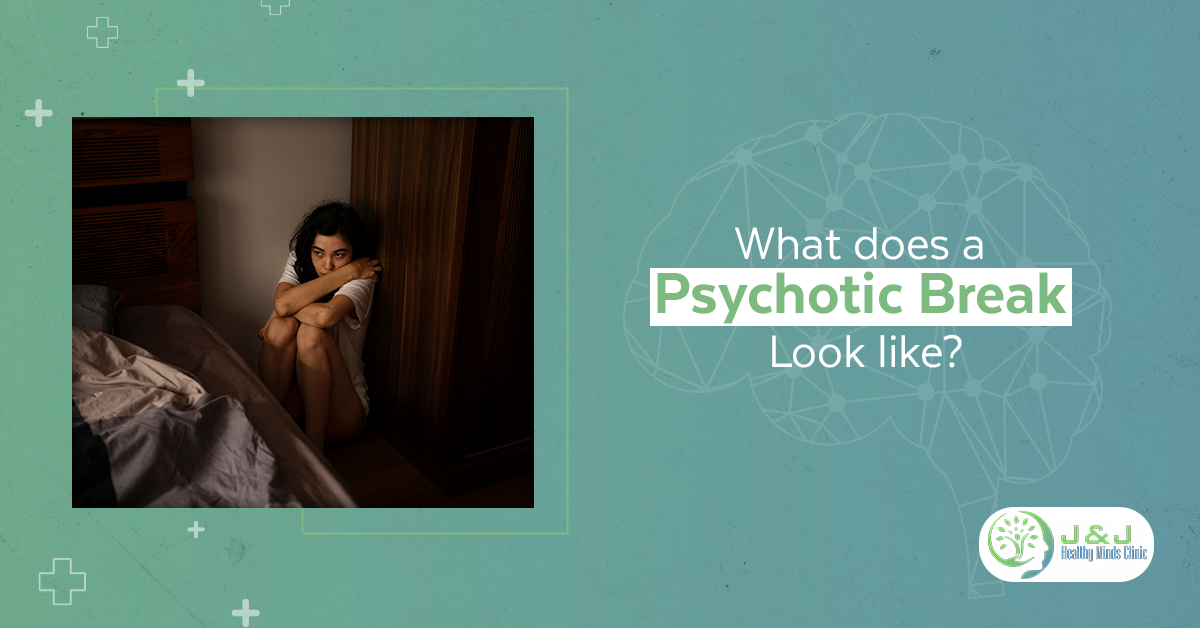A psychotic break immerses a person in deep confusion. They may struggle to tell reality from swirling delusions or vivid hallucinations. This unsettling experience fills both the individual and their loved ones with fear. By learning “What Does a Psychotic Break Look Like” you can spot the telltale signs. Recognizing these signs helps you guide them to the care they need.
At J & J Healthy Minds Clinic, we’re here to help you understand and manage psychotic breaks. Our compassionate team provides customized care to support your mental health journey. Contact us today.
What Is a Psychotic Break?
A psychotic break means losing touch with reality. They might hear whispers from shadows, speaking only to them. They could see visions just out of the corner of their eye. Some may believe things that are like mirages in the desert. This break can happen suddenly or gradually. Often, extreme stress, mental illness, or substance use lead to this state. During this time, people may feel like lost ships in a storm, overwhelmed by confusion and fear. They may also seem “out of touch with reality” to others around them.
Common Signs of a Psychotic Break
Spotting a psychotic break can be lifesaving. Swift action is essential. Watch for these key indicators:
- Hallucinations: Experiencing sights or sounds that exist only in the mind’s theater.
- Delusions: Strong beliefs in the fantastic, such as having superpowers or a constant threat of harm.
- Confused Thinking: Struggling with clarity, thoughts may spiral into a tangled web.
- Behavior Changes: Sudden expressions of surprise, like striking up conversations with imaginary friends.
- Strong Emotions: Intense anger, fear, or sadness can arise without reason. They may cause unsettling anger and psychosis episodes.
Why Do Psychotic Breaks Happen?
A psychotic break can arise from various triggers. Recognize these to prevent or get timely support.
- Stress Overload: When pressure becomes too much, the mind can crack. It’s a vibrant red flag, indicating that the brain has reached its limit.
- Substance Use: Drugs or alcohol can change brain function. They can trigger a psycho break in some people.
- Mental Health Conditions: It has been found that schizophrenia, bipolar disorder, or severe depression can lead to a person having an experience of a breaking reality moment.
- Trauma: Sudden, shocking events can blur reality and illusion. Losing a loved one or facing danger can push a person to the edge.
Signs Someone is Out of Touch with Reality
Spotting a psychotic break can feel like navigating a foggy maze. Here are some telltale signs someone might be drifting out of touch with reality:
- Engaging in conversations with invisible friends or reacting to phantom voices.
- Nurturing faith in the strange and the seemingly impossible.
- Growing distant from friends and family, lost in waves of misunderstanding.
- Exhibiting a fear of harmless sounds or ordinary objects that pose no threat.
Catching these hints early can be a lifeline, steering them away from deeper troubles.
What Happens During a Psychotic Break?
When a psychotic break strikes, reality can warp into a twisted illusion. For example:
- They may feel shadows stalking them, though no one is there.
- They could dive deep into a “psychotic obsession,” fixating on a single thought.
- Their behavior may shift dramatically, from silent solitude to wild exuberance.
These experiences create a chasm, isolating them from those nearby. Confusion and loneliness become their constant companions.
How Long Does Psychosis Last?
Psychotic episodes vary in duration, each story uniquely woven. Some may find themselves trapped for mere hours, while others endure days or weeks. Psychosis lasts longer or shorter depending on its cause and treatment. Without support, these episodes risk becoming more frequent and increasingly difficult to navigate.
Helping Someone during a Psychotic Break
When a loved one faces a psychotic break, your calmness is crucial. Here’s your guide to guiding them through this challenging chapter:
- Stay Calm: Use a low voice and gentle movements. They may feel very anxious.
- Listen: Let them express their thoughts, no matter how scattered. Avoid correcting or debating. Your understanding is what matters most.
- Reassure Them: Gently remind them they are safe. Show them you’re ready to support and lend your helping hand.
- Seek Professional Help: Don’t hesitate to call a doctor or therapist.
Make sure their surroundings are secure. This helps protect them from harm during this episode.
Can a Psychotic Break Be Prevented?
Taking care of your mental health can prevent psychotic breaks. Here are some tips to help:
- Manage Stress: Take deep breaths, exercise, or enjoy a calming hobby. These activities release tension.
- Get Enough Sleep: A rested mind is strong and ready for the day.
- Avoid Drugs and Alcohol: Stay away from these traps. They can increase the risk of psychosis.
- Take the Therapy Train: Engage in regular chats with a therapist. Unearth hidden emotions and discover early warning signs before they bloom.
- Nurture Your Network: Reach out to friends, family, or support groups. Connection makes solitude a source of strength.
Anger and Psychosis: Why Do They Happen Together?
During a psycho break, emotions can be very difficult to control. Anger often goes hand in hand with psychosis. Frustration and fear about their situation can spark this inner chaos. When reality mixes with intrusive thoughts, anger can erupt. Staying calm and providing a soothing presence can help lessen these emotional fires.
Life after a Psychotic Break
Bouncing back from a psychotic break is a journey, not a sprint. Here’s what typically unfolds next:
- Medical Assessment: A doctor will dive deep to uncover the cause. They may recommend therapy or medication to smooth the ride ahead.
- Building Support Systems: Loved ones are anchors. They help rebuild confidence and reconnect with reality.
- Learning Coping Skills: Therapists share tools to manage stress and spot warning signs.
- Focus on Wellness: Healthy habits improve mental stability. Exercise, eat well, and be mindful.
Breaking Reality: What It Feels Like
When someone is breaking reality, it feels like their world has turned upside down. For example:
- They might feel like they’re living in a dream.
- Everyday objects or situations may seem unreal or threatening.
- They may struggle to explain their feelings, leaving them isolated or confused.
Support and professional help can make a big difference. They can guide someone back to stability.
Final Thoughts: What Does a Psychotic Break Look Like?
A psychotic break may feel like a storm, but it’s not the final curtain. With compassion and understanding, a brighter path to recovery awaits. You can be the anchor in someone’s healing journey. Spot the signs, extend a hand, and encourage treatment. Remember, some can assist you. These waters should never be parted alone. If you or someone you know is in need, contact a mental health professional today.
FAQs
What is a psychotic break?
A psychotic break is when reality slips through your fingers. It leads to delusions, hallucinations, and tangled thoughts that distort perception.
What causes psychotic breaks?
Psychotic breaks can be ignited by stress, trauma, or the shadows of mental illness. Substances may also play their part in this troubling transformation.






No comment